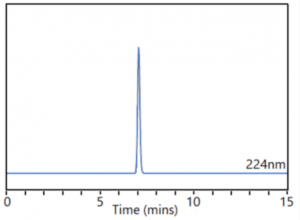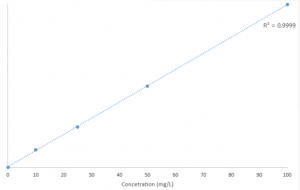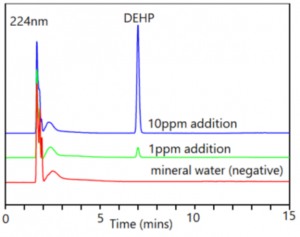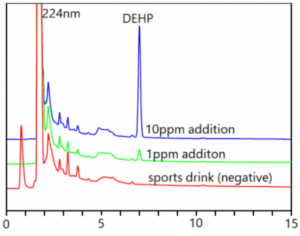Analysis of DEHP in Drinking Water by HPLC-DAD
Introduction
DEHP, bis-(2-ethylhexyl)phthalate, is one of the most prominent phthalate contaminants in drinking water. DEHP is also used as a plasticiser during plastic manufacturing. When ingested, it is a cancer-causing hazard and presents a high risk of liver function disorders. For this reason DEHP is a banned substance during food production, under the Restriction of Hazardous Substances (RoHS) Directive by the EU[1], and levels must be monitored. Although a banned substance, commercial sport drink manufactures have been known to substitute palm oil, a common emulsifier, for the more cost effective DEHP.
SCION Instruments developed a method for the identification of DEHP using HPLC and a Diode Array Detector (DAD).
Experimental
A SCION LC 6000 with DAD was used with a C18 reverse phase column for the detection of DEHP in mineral water and sports drink samples. A DEHP analytical standard was prepared at a concentration range of 0.1mg/L to 100mg/L. Standard addition was also performed on two negative water and sports drink samples to demonstrate the capability of the instrument. Samples were spiked with 1ppm and 10ppm of DEHP prior to analysis.
Table 1 details the analytical conditions of the HPLC-DAD system.
Table 1. Analytical conditions of HPLC-DAD
| Conditions | |
| Column | C18 5µm x 4.6mm ID x 150mm |
| Column Temp | 30°C |
| Mobile Phase | Water/Acetonitrile (2/98 v/v) |
| Flow Rate | 1mL/min |
| Injection Vol | 10µL |
| DAD | 224nm |
Results
The chromatogram of a 10mg/L DEHP standard can be observed in Figure 1 whilst Figure 2 shows the calibration curve of DEHP, over a range of 0.1mg/L to 100mg/L.

Figure 1. Identification of DEHP at 224nm (10mg/L)

Figure 2. Calibration curve of DEHP; 0.1mg/L to 100mg/L
DEHP exhibits excellent linearity over a wide concentration range, as demonstrated in Figure 2. Retention time and peak are repeatability of the system was tested with six consecutive injections of a 10mg/L standard, the values of which can be found in Table 2.
Table 2. Repeatability values of 10mg/L DEHP standard (n=6)
| Run | RT (min) | Peak Area |
| 1 | 7.058 | 131486 |
| 2 | 7.057 | 131742 |
| 3 | 7.056 | 131456 |
| 4 | 7.057 | 131769 |
| 5 | 7.056 | 131609 |
| 6 | 7.057 | 131743 |
| Mean | 7.057 | 131634 |
| %RSD | 0.011 | 0.11 |
Excellent repeatability of both retention time and peak value was observed, with RSD% values at 0.011 and 0.11, respectively; highlighting the robustness of the SCION HPLC-DAD system.
Mineral water and a sports drink were both analysed for the presence of DEPH. However, both samples were negative. Standard addition was performed on two separate samples of each sample type with an addition of 1ppm and 10ppm DEHP.
Figures 2 and 3 show the overlay chromatograms of both samples, including the initial blank results and both DEPH additions.

Figure 3. Chromatogram overlay of DEHP standard addition (mineral water)

Figure 4. Chromatogram overlay of DEHP standard addition (sports drink)
The above figures demonstrate the excellent sensitivity of the HPLC-DAD system even at low concentrations such as 1ppm.
Conclusion
SCION Instruments offers the ideal solution for the identification of DEHP, a restricted contamination compound by HPLC-DAD. Excellent separation, linearity over a wide concentration range and system repeatability was observed for DEHP using a C18 column at 280nm wavelength.
References
[1] European Commission (2011). Directive 2011/65/EU of the European Parliament and of the Council as Regards the List of Restricted Substances. European Parliament.
Download Application Note
Download complete Application Note: Analysis of DEHP in Drinking Water by HPLC-DAD
Keep in Touch
If you wish to speak to a member of our team about more information, please don’t hesitate to contact us. Or if you wish to keep up to date with SCION Instruments latest research and articles, why not join us on social media and sign up to our newsletters today?
